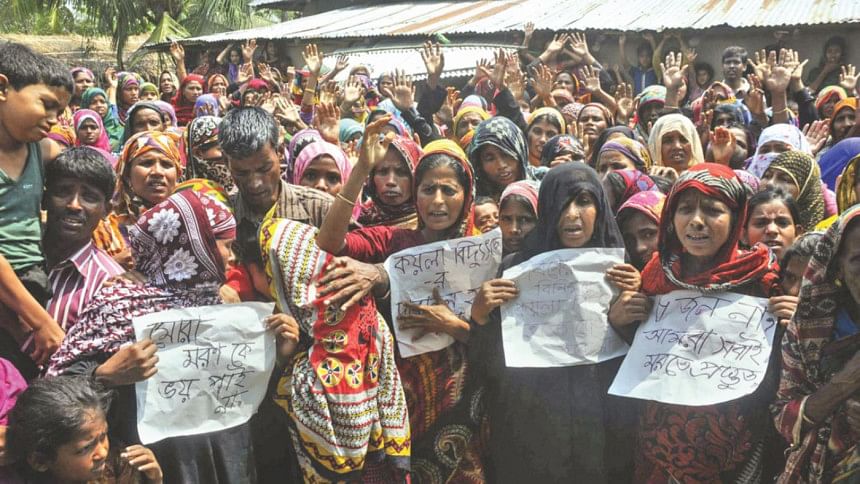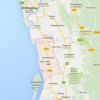Banshkhali Coal Power Plant Propaganda and Reality

I had the opportunity to visit Gondamara of Banskhali upazila as part of a fact finding mission organised by the National Committee to Protect Oil-Gas-Mineral Resources, Port and Power on April 8. I wanted to understand why the locals were resisting the proposed coal-fired power plant and what led to the killing of people on April 4. The role of the police and the S. Alam group in the Banshkhali killings has already been exposed. Here I explore the rationale behind the local uprising against the coal power plant.
The proponents of the project argued that people were instigated by some 'vested quarters' which provided them 'misinformation', thus leading to this tragic incident. However, I found the local people to be very well-informed about the impacts of the coal power plant and felt that they did not need to be 'instigated' by 'misinformation' to protest against the said plant. Let me give some examples.
I asked one young man, "Why are you against the coal power plant?"
He replied, "There will be huge amounts of toxic smoke and ash from the stack of the coal power plant".
I challenged him, "How can you say so? Have you seen any?"
He then showed me a video on his mobile phone where a lot of smoke was coming out of the stack of a coal power plant in another country.
I learned that people in the area had been familiarised on the issue through videos, articles and debates via an educated section of the community. This community has also read newspaper articles and booklets published as part of the campaign against the setting up of a coal power plant near the Sundarbans, and even discussed its impact with others. As a result, the local farmers, housewives, salt workers, fisherman, etc. were very aware of the impacts of the coal power plant on health, local agriculture, water and aquatic life.
A local fisherman told me that the hot water discharge from the power plant would have negative impact on the availability of fish. This reminded me of a study report of JICA on the impacts of coal-fired power plant in Chittagong. The report acknowledged: "Sea area in front of the power plant is open water, and thermal effluent is diffused at the surface layer. Fish avoid the sea area if it exceeds a suitable water temperature, therefore living fish are likely to be impacted even though the thermal effluent is diffused." ("Preparatory Survey on Chittagong Area Coal Fired Power Plant Development Project in Bangladesh," Japan International Cooperation Agency (JICA), Tokyo Electric Power Services Co., LTD and Tokyo Electric Power Co., LTD, 2015). Local people also expressed their concerns on the possible impact of gaseous emission and fly ash on their health and agricultural production. These are all very legitimate concerns as there are numerous examples all over the world of how big coal-fired power plants have caused havoc on health, life, agriculture and environment. For example, a study on the impact of Dahanu coal power plant in Maharashtra, have found that "During the period of 1995 to 2003 the overall yield of Sapota from Dahanu's orchards dropped by around 60 percent." ("Impact of coal-fired thermal power plants on Agriculture: A case study of Chicku Sapota orchards of Dahanu Maharashtra," Arun. P. R., Azeez PA and Maya V. Mahajan, Global Environment: Problems and Policies, 2009). Another study on the impact of coastal coal-fired power plants in Andhra Pradesh and Tamil Nadu concludes, "Coastal thermal power plants have massive and serious impacts on the local water systems, local communities and livelihoods. They were found to have salinized groundwater, contaminated local water bodies, disrupted water drainage patterns, dumped pollution irresponsibly, impacted yields of fish and affected people's livelihoods." ("Impacts of Coastal Coal Based Thermal Power Plants on Water Report of Visit to Some Operational and In Pipeline Plants in Andhra Pradesh and Tamil Nadu," Manthan Adhyayan Kendra, 2014).
My next question was: "Then how could S. Alam group manage to buy 660 acres of land from you for the power plant?" They argued that S Alam group had bought land from them saying that it would build garments and other factories which would generate huge employment in the area. In recent days, S Alam Group denied this allegation in their advertisement titled "Confusion and Reality" published in almost all national or local newspapers. However, a letter issued by Bashkhali Upaziala land office dated November 15, 2015 clearly mentioned that 660.40 acres of land was bought by S Alam group to be used for setting up the "Genesis Textile and Apparels Limited" and "S.Alam Vegetable Oil Ltd"! Moreover, the local land office had issued this clearance for S. Alam Group, after showing that there are only 150 households in the entire area. However, according to locals I interviewed, there are more than 7,000 households with several mosques, schools, bazaars, and health clinics in the area, which seems more credible to me, as per my observations of the three unions in that area. The letter also mentioned that S Alam Group's original intention was to own 5,032.14 acres of land to build two 1,320 MW coal-based thermal power plants, of which 1,728.97 acre is Khas land and 3,303 acres is private land. The Land Office gave its clearance to S Alam Group to buy 3,000 acres of land, terming the acquired land as "barren land"; this is also a baseless claim, as I have myself seen that the land is fertile with rice and salt farming.
While the JICA report acknowledged that "there will be permanent losses or reduction of livelihood means in salt farming, shrimp farming and fishing activities", in its advertisement, S. Alam Group claimed that 1,000 people would be given permanent employment after the project is completed. When I asked local people about their opinion on this prospect, they simply rejected it by saying, "What will we do with 1,000 jobs when the power plant will destroy the livelihoods of 50,000 people?" We need to note here that the villagers of Krishnapattam region of Andhra Pradesh, India, were also promised thousands of jobs, but in reality, the huge capital investments in the port and power plants, that promised development for the local communities, have, at best, offered them jobs of sweepers and security guards, and that too, on a contractual basis ("Breaking the myth behind Coastal Thermal Power Plants", indiatogether.org, July 28, 2014).
While S. Alam Group uses examples of China, India and other countries in its advertisement to justify its coal power plant, the real picture is rather bleak for proponents of coal-fired power plants. Beijing, where pollution averaged more than twice the national standard pollution of China last year, will close the last of its four major coal-fired power plants next year ("Beijing to Shut All Major Coal Power Plants to Cut Pollution", Bloomberg, March 24, 2015).
While India continues to build coal power plants, it at least imposes restrictions on building coal-fired power plants not only near forests, but also near human habitats and agricultural land. India's Environmental Impact Assessment (EIA) Guideline 2010 prohibits coal-fired power plant within 25 kms of metropolitan areas. Recently, a central green panel of India refused to give approval to the National Thermal Power Corporation (NTPC) to set up a 1,320 MW coal-based project in Madhya Pradesh, noting that a thermal power plant near human habitat and on agricultural land was not viable ("NTPC's coal-based project in MP turned down", The Hindu, October 8, 2010).
But in Bangladesh, local and foreign private and public companies are being allowed to build huge coal-based thermal power plants near reserve forests like the Sundarbans, heavily populated areas, and agricultural lands. Bangladesh does not have sufficient regulations and EIA guidelines to protect forests, wetlands, and agricultural lands. Although insufficient, the acts and guidelines we have are not strictly followed. In the Bashkhali case, S. Alam Group bought land concealing information, started constructing pillars, deployed excavation machines for land development and also set up temporary tin-sheds to monitor and manage the work, without taking any of the three clearance certificates - site clearance, EIA approval, and environment clearance – which are mandatory for any red-listed projects like the coal power plant, according to the Bangladesh Environment Protection Act 1995 ("Banshkhali power plant yet to get environmental clearance", Prothom Alo, April 10, 2016)!
The government needs to understand that the population density of Bangladesh is much higher than that of China, India or USA. So, the 'big country mega project model', which requires huge amounts of land and risks the livelihood of thousands of people, cannot be followed in Bangladesh. It would be best if we can completely avoid destructive coal-fired power plants, but if that's not possible then we can build smaller units (say 100 MW), considering the impacts on local agriculture, health and environment and following strict rules and regulations. We need to learn to sacrifice profits, instead of sacrificing lives and livelihoods.
The writer is an engineer and member of National Committee to Protect Oil-Gas-Mineral Resources, Port and Power.

 For all latest news, follow The Daily Star's Google News channel.
For all latest news, follow The Daily Star's Google News channel. 








Comments